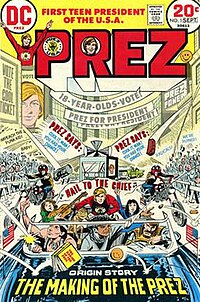
Neil Richard MacKinnon Gaiman is an English author of short fiction, novels, comic books, graphic novels, nonfiction, audio theatre, and films. His works include the comic book series The Sandman and novels Stardust, American Gods, Coraline, and The Graveyard Book. He has won numerous awards, including the Hugo, Nebula, and Bram Stoker awards, as well as the Newbery and Carnegie medals. He is the first author to win both the Newbery and the Carnegie medals for the same work, The Graveyard Book (2008). In 2013, The Ocean at the End of the Lane was voted Book of the Year in the British National Book Awards. It was later adapted into a critically acclaimed stage play at the Royal National Theater in London, England that The Independent called "...theater at its best".

Worlds' End (1994) is the eighth collection of issues in the DC Comics series The Sandman. It was written by Neil Gaiman; illustrated by Michael Allred, Gary Amaro, Mark Buckingham, Dick Giordano, Tony Harris, Steve Leialoha, Vince Locke, Shea Anton Pensa, Alec Stevens, Bryan Talbot, John Watkiss, and Michael Zulli; colored by Danny Vozzo; and lettered by Todd Klein. The stories in the collection first appeared in 1993. The collection first appeared in paperback and hardback editions in 1994 with an introduction by Stephen King. The collection's title, setting, and a number of its themes and images are also found in G.K. Chesterton's poem "A Child of the Snows".

The Sandman is a comic book written by Neil Gaiman and published by DC Comics. Its artists include Sam Kieth, Mike Dringenberg, Jill Thompson, Shawn McManus, Marc Hempel, Bryan Talbot, and Michael Zulli, with lettering by Todd Klein and covers by Dave McKean. The original series ran for 75 issues from January 1989 to March 1996. Beginning with issue No. 47, it was placed under DC's Vertigo imprint, and following Vertigo's retirement in 2020, reprints have been published under DC's Black Label imprint.
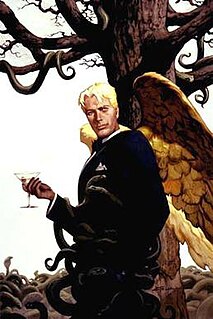
Lucifer Samael Morningstar is a character who appears in American comic books published by DC Comics. He is an adaptation of Lucifer—the Biblical fallen angel and devil of Christianity—and is one of the most powerful beings in the DC Universe. Though various versions of the Devil have been presented by DC Comics, this interpretation by Neil Gaiman debuted in The Sandman #4 in 1989. Lucifer appears primarily as a supporting character in The Sandman and as the protagonist of the spin-off Lucifer.

Joseph Henry Simon was an American comic book writer, artist, editor, and publisher. Simon created or co-created many important characters in the 1930s–1940s Golden Age of Comic Books and served as the first editor of Timely Comics, the company that would evolve into Marvel Comics.

Sandman is a fictional superhero who appears in American comic books published by DC Comics. The first of several DC characters to bear the name Sandman, he was created by writer Gardner Fox and artist Bert Christman. Attired in a green business suit, a fedora, and a World War I gas mask, the Sandman used a gun emitting a sleeping gas to sedate criminals. He was originally one of the mystery men to appear in comic books and other types of adventure fiction in the 1930s but later was outfitted with a unitard/cowl costume and developed into a proper superhero, acquiring sidekick Sandy, and founding the Justice Society of America.

The Sandman is the pseudonym of several fictional characters appearing in comic books published by DC Comics. They have appeared in stories of various genres, including the pulp detective character Wesley Dodds, superheroes such as Garrett Sanford and Hector Hall, and mythic fantasy characters more commonly called by the name Dream. Named after the folklore character that is said to bring pleasant dreams to children, each has had some thematic connection to dreaming, and efforts have been made to tie them into a common continuity within the DC Universe.

Cain and Abel are a pair of fictional characters in the DC Comics universe based on the biblical Cain and Abel. They are key figures in DC's "Mystery" line of the late 1960s and 1970s, which became the mature-readers imprint, Vertigo, in 1993.

The Super-Sons are a pair of fictional characters appearing in American comic books published by DC Comics. The characters were created by Bob Haney and Dick Dillin and first appeared in World's Finest Comics #215. The characters were featured in stories about the sons of Superman and Batman.
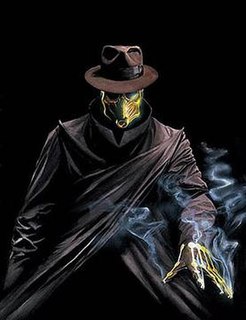
Sanderson "Sandy" Hawkins, formerly known as Sandy the Golden Boy, Sands, Sand and eventual successor of his mentor Wesley Dodds as Sandman, is a fictional character and a superhero in the DC Comics universe. Created by writer Mort Weisinger and artist Paul Norris, he first appeared in Adventure Comics #69. After being unutilized for several years, he was reintroduced by writers David S. Goyer and Geoff Johns in the comic JSA in the late 1990s and with a greatly expanded set of powers and responsibilities. He eventually became a new version of his former mentor, donning the identity and costume of Sandman.
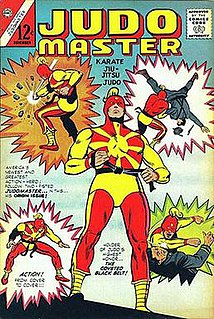
Judomaster is the name given to four fictional superheroes published by DC Comics. The first Judomaster debuted in Special War Series #4 published by Charlton Comics, and was created by Joe Gill and Frank McLaughlin.
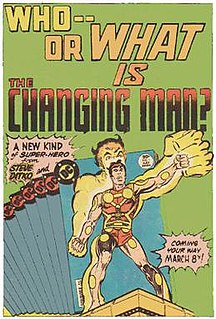
Shade, the Changing Man is a comic book character created by Steve Ditko for DC Comics in 1977. The character was later adapted by Peter Milligan and Chris Bachalo in one of the first Vertigo titles.

Dark Circle Comics is an imprint of Archie Comics Publications, Inc. Under its previous name, Red Circle Comics, it published non-humor characters, particularly superheroes in the 1970s and 1980s, and was a digital imprint from 2012 to 2014. In 2015, it was converted back to a print imprint and was completely revamped as Dark Circle Comics, featuring darker and more mature content than previous incarnations of Archie's superhero line.
Swing with Scooter was a DC Comics teen-humor American comic book published from 1966 to 1972. It starred a British teenage musician nicknamed Scooter who lived in the US.

Theodore "Ted" Grant (Wildcat) is a fictional character, a DC Comics superhero, known as the original Wildcat and a long-time member of the Justice Society of America (JSA). A world-class heavyweight boxer, Grant became entangled inadvertently in the criminal underworld and developed a costumed identity to clear his name.
Charles J. "Jerry" Grandenetti was an American comic book artist and advertising art director, best known for his work with writer-artist Will Eisner on the celebrated comics feature "The Spirit", and for his decade-and-a-half run on many DC Comics war series. He also co-created the DC comic book Prez with Joe Simon.

"The Sandman Saga" is a Superman story arc published in 1971 in Superman #233 - 235, #237 - 238 and #240 - 242. This is the first Superman storyline under editor Julius Schwartz and the first Bronze Age-era Superman story.

Men of War is the name of several American comic book series published by DC Comics. For the most part, the series was a war comics anthology featuring fictional stories about the American military during World War II.

The Endless are a family of beings who appear in American comic books published by DC Comics. The members of the family include Death, Delirium, Desire, Despair, Destiny, Destruction, and Dream.
All-Out War is an American war comics anthology series published by DC Comics from 1979 to 1980. It primarily featured characters created by writer Robert Kanigher.
